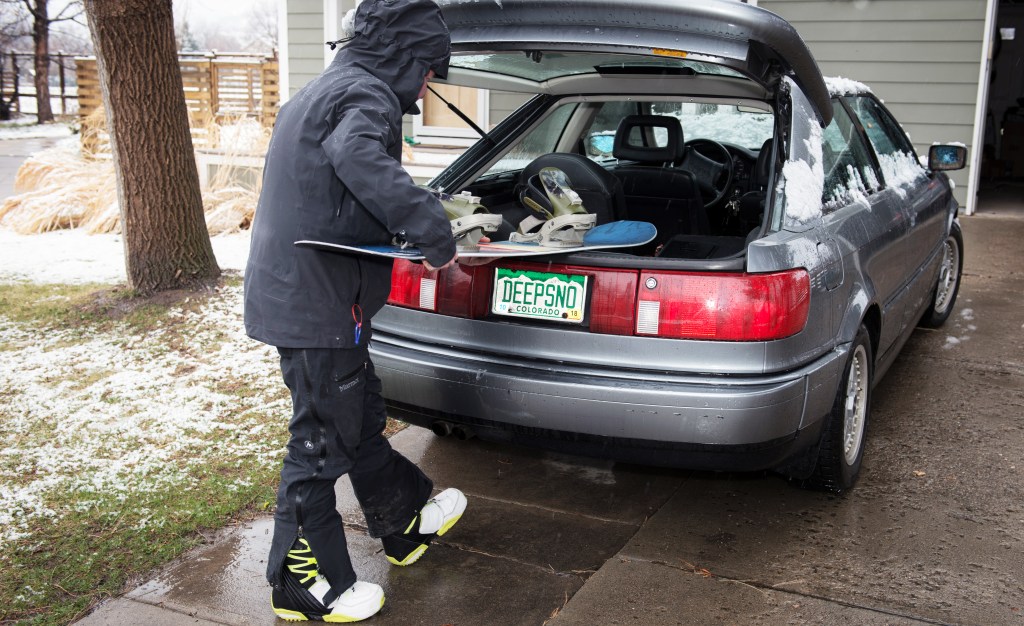It’s 5pm on a Monday in March, and Powderchaser Steve is tired. He just got home from Steamboat Springs, Colorado, chasing his sixth straight deep powder day at his fourth resort in three states. When he left his home in Boulder at 4am this morning, he was still half asleep. Seventeen inches of fresh, light powder woke him up. Just as 20 inches of fresh snow had woken him up the prior morning at Snowbird, Utah, and before that, three consecutive deep-snow mornings dragged him out of bed at Mammoth and Squaw Valley, California.
Today was good but not perfect—too many people on the hill, says Steve, a snowboarder who declines to give his full name out of fear that his boss might recognize him. (Despite the fact that he still performs his professional duties, he says, he often works at odd hours and figures it’s best that his boss doesn’t know he chases storms.)
Steve organizes his entire life around scoring fresh tracks. He works as an outside sales rep for a healthcare company, though his job seems like more of a footnote given his lifestyle. He founded Powderchasers.com a decade ago and writes “The Chase” report on the weather forecasting site OpenSnow.com. He spends three hours a day researching where to find deep snow and up to 40 days a winter chasing storms across the West.
“I don’t know how I’ve gotten away with it, but none of my bosses have ever known about this,” he says. As for why he takes the chance that his employer might find out, Steve says the reward far outweighs the risk. “It’s all about the endorphins you get from that first, deep powder run. I will literally chase for one run.”
The 57-year-old son of a cancer researcher, Steve grew up in the suburbs outside of New York City, where he began a lifelong fascination with snow. He started chasing storms in high school, often booking last-minute flights to Colorado if he saw a potent storm approaching.

Steve loads up his car for the next chase.
Today, thanks to modern technology like social media and online weather forecasting tools, it’s easier than ever to predict what a storm is going to bring. It didn’t used to be so easy, chasing powder. Before live web cameras and, well, sites like his that provide a blueprint for how and where to find deep snow, powder chasing was “way better,” Steve says.
Back in the day, Steve kept a little black book with ski-town phone numbers for every gas station that stayed open after midnight and every hotel with a night auditor. “I would call them in the middle of the night and have them tell me exactly how much snow was outside their door in exchange for a six-pack,” he says. “I even had the number for the Eisenhower Tunnel and a Colorado Department of Transportation shed at the base of Rabbit Ears Pass. I would dial that number until finally somebody would answer, because when they’re out plowing they’re not in there. Then the guy would tell me there was 11 inches on the pass, or whatever it was.”
Now he splits his time between Park City, Utah, and Boulder, Colorado. “Between those two places, I can chase anywhere in the West,” he says. “From Utah you can chase to Jackson or Targhee in four and a half hours. I do that a lot. You can chase to Squaw in nine or 10 hours. You can be in Colorado in five hours.”
Lest one confuse storm chasing with road tripping, keep in mind that Steve travels halfway across the country on a whim—oftentimes just for one day. He masters airline booking (and rebooking) policies and keeps spare gear in a storage shed in Seattle so he doesn’t always have to fly with ski gear. He abides by a strict set of self-imposed policies.
“It’s got to be double digits,” he says, referring to the new snowfall. “This year was an anomaly, so I was chasing six inches sometimes. But usually the minimum is 10 inches. The snow quality needs to be good. I’m not chasing storms that are extremely dense. I don’t want to sound like a snob, but I’m not going to chase a storm with a freezing level at the base of the mountain. And I’m not going to chase a storm with excessive winds, because winds could keep the mountain closed or mess up the snow.”
That being said, any powder chaser must be prepared for what he calls The Big Letdown, where a storm doesn’t deliver on its forecast. It happens sometimes, though less frequently now than a decade ago.
He somehow manages to keep his day job while dropping everything to score a powder day. Steve once dialed into a work conference call from the hill, handed his phone to a liftie, rode up the chair and took a run, then asked the liftie for an update when he reached the bottom. Despite how heavily powder hounds rely on forecasts like the ones he writes—along Colorado’s Front Range, for example, weekend warriors often save their sick days to chase weekday storms—he doesn’t worry that his storm-chasing reports will lead to overcrowding and thus ruin the experience for him or anyone else. Because even if he shut down his site, others would fill the void, he says.
Instead, he spends his time poring over weather models and searching for the next deep day, wherever it may be. “For the ultimate run,” he says, “it’s every bit worth it.”
